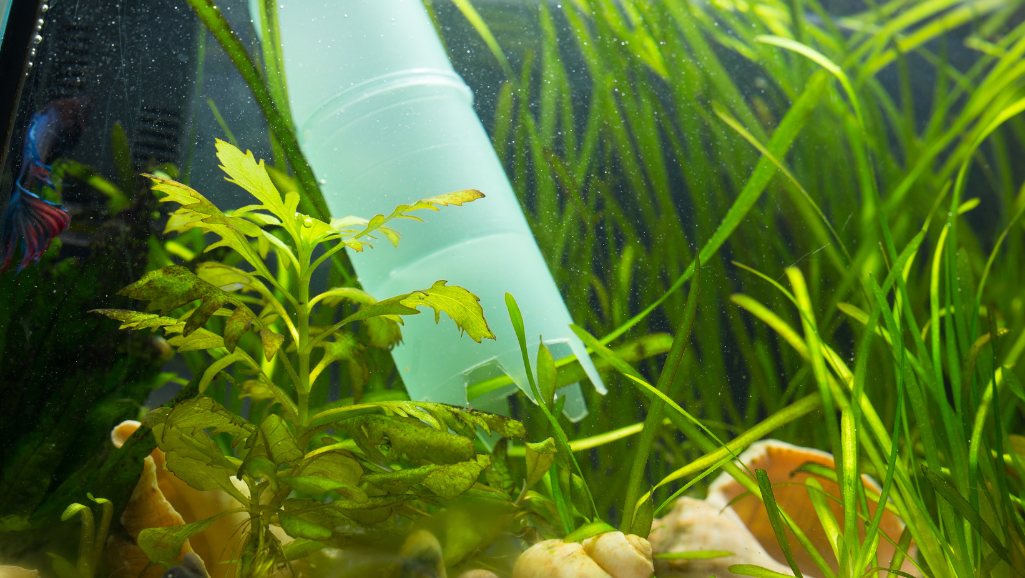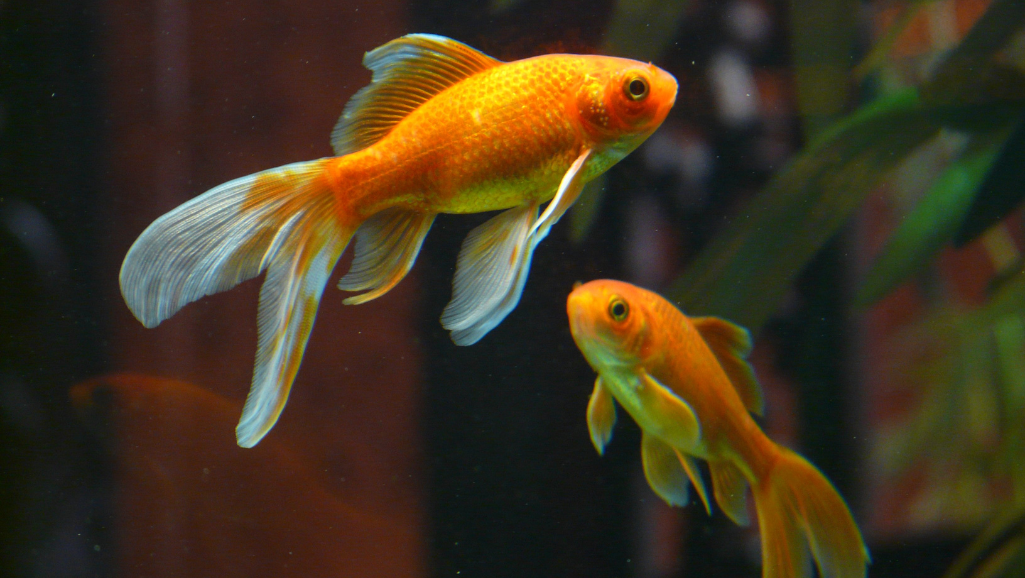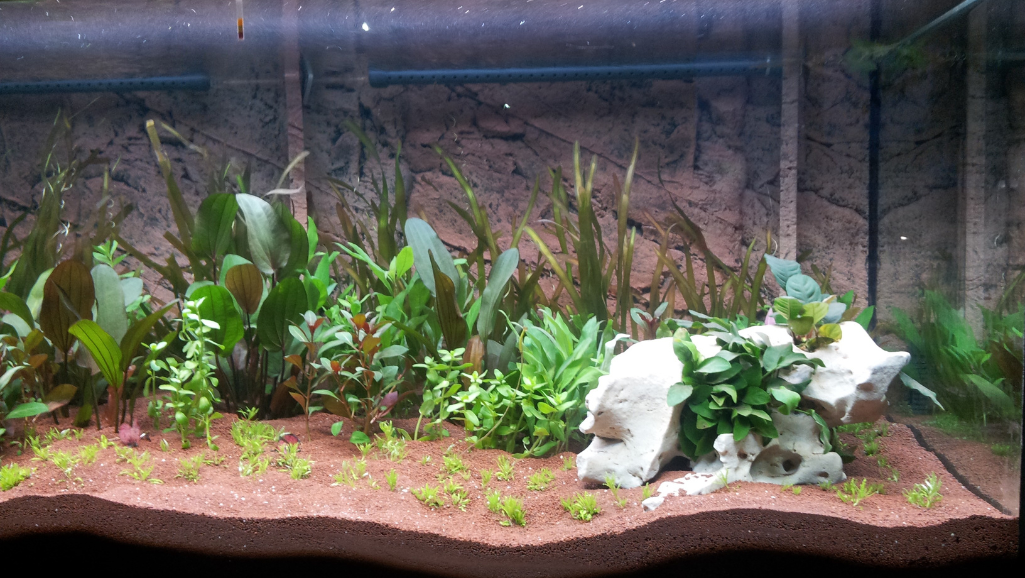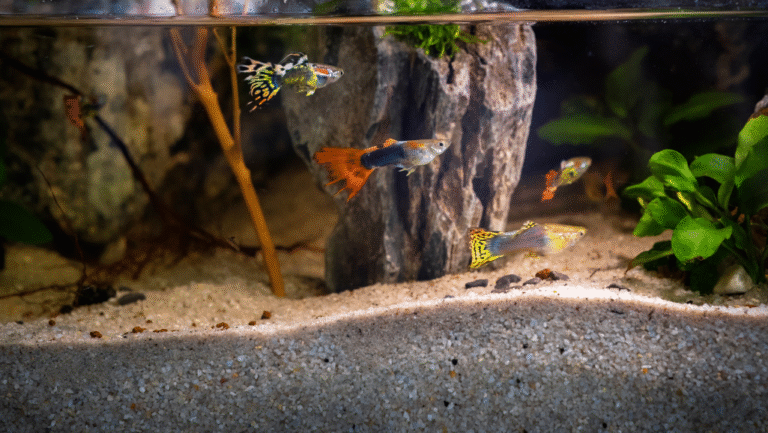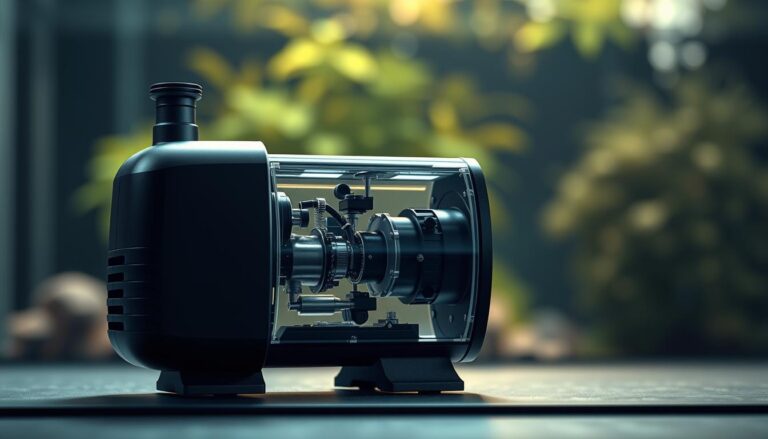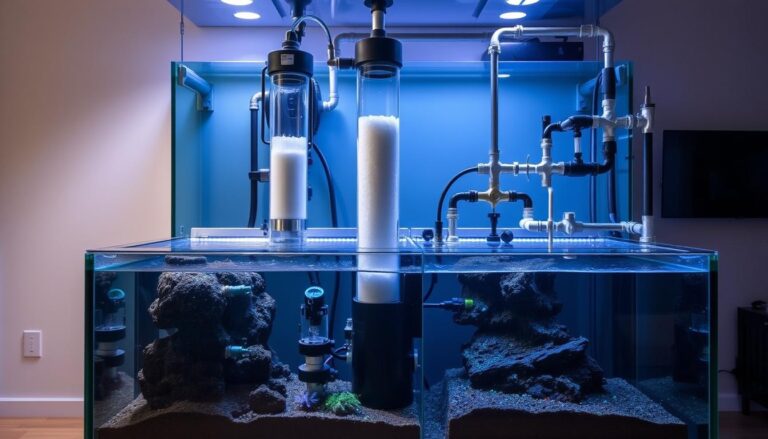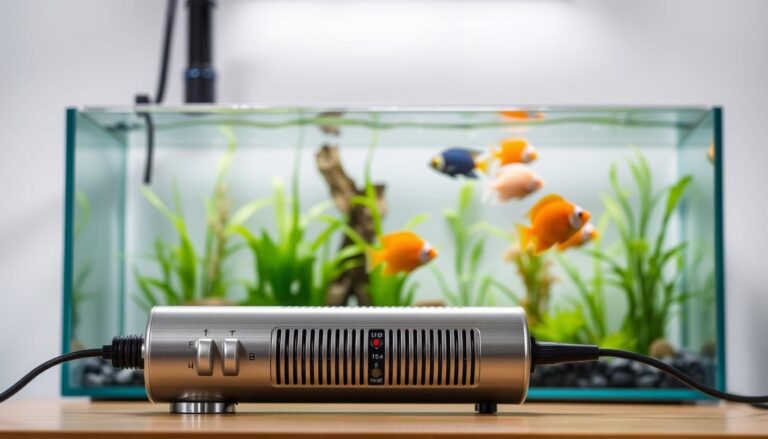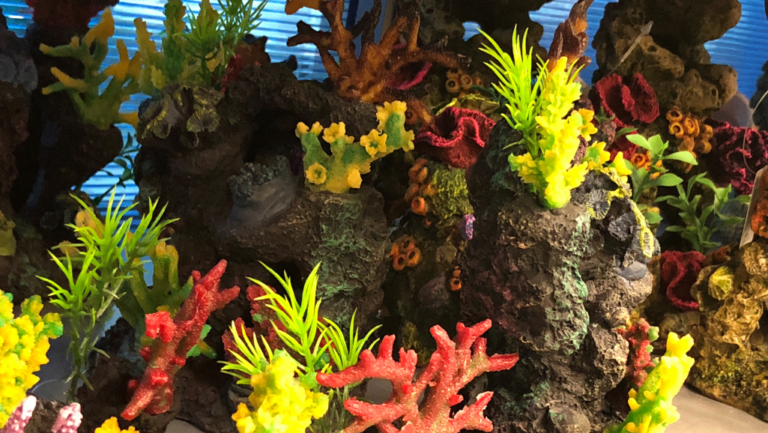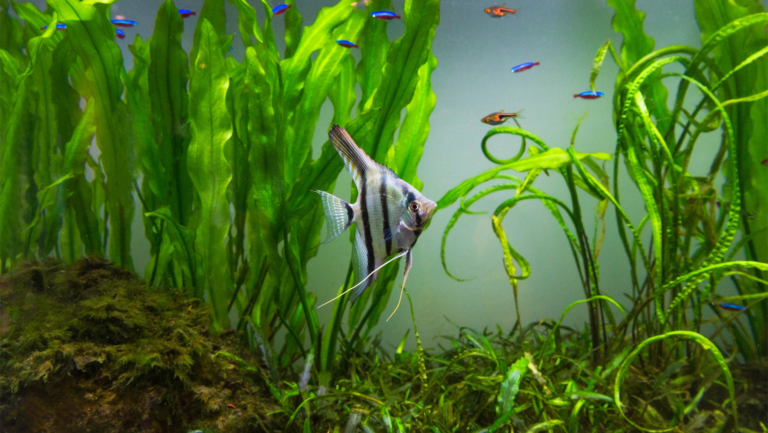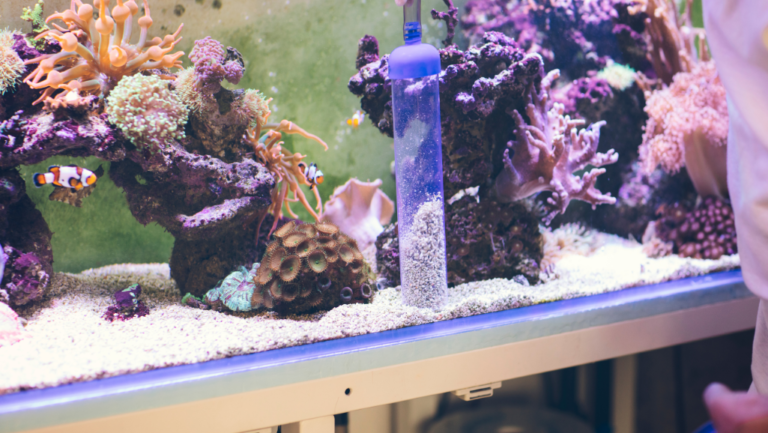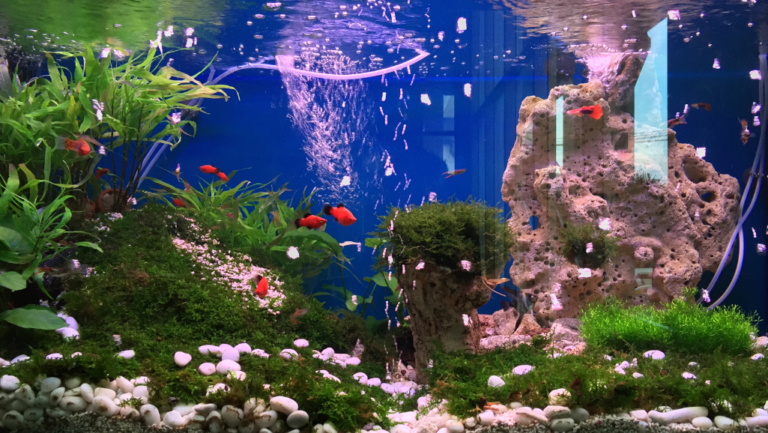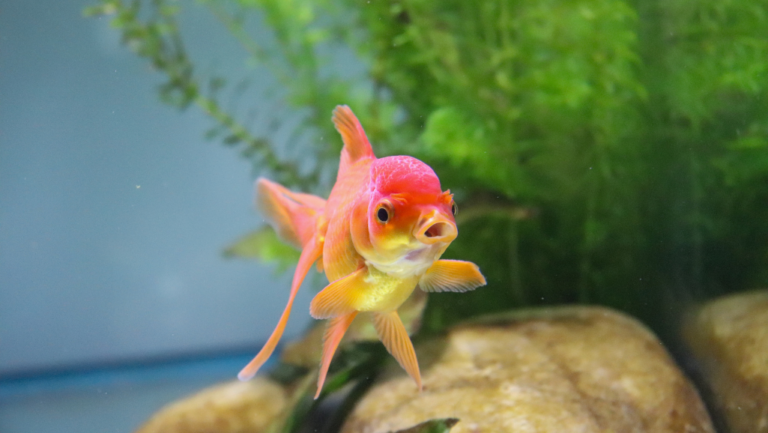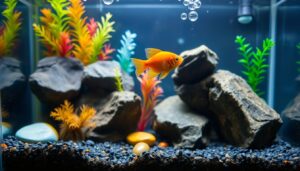Imagine a world under water where fish swim freely and plants move with the current. This dream can come true with an aquarium circulation pump in your tank. These pumps are key to keeping your aquarium healthy and balanced for your fish.
Water circulation is vital for both saltwater and freshwater tanks. It stops dead zones, spreads nutrients, and boosts oxygen levels. An aquarium water pump stirs waste, helping filters work better and feeding plants for growth. It also improves gas exchange, giving fish the oxygen they need.
Getting an aquarium pump makes your tank look better and healthier. With the right pump, your tank will be full of life. Say hello to a vibrant, thriving underwater world that will amaze everyone.
Key Takeaways
- Aquarium circulation pumps are key for a healthy tank in both saltwater and freshwater.
- Good water flow stops dead zones, spreads nutrients, and boosts oxygen for fish and plants.
- Circulation pumps help stir waste, ensuring filters work well and keeping the tank clean.
- They also improve gas exchange, giving fish the oxygen they need to live.
- Getting a fish tank circulation pump makes your tank look better and healthier for your fish and plants.
Introduction to Aquarium Circulation Pumps
Discover the secret to a thriving aquatic ecosystem: aquarium circulation pumps. These essential devices, also known as aquarium wavemakers or powerheads for aquariums, create a dynamic water flow. This brings your tank to life. With the right reef tank wavemaker, you can mimic the natural currents found in oceans and rivers.
What Is an Aquarium Circulation Pump?
An aquarium circulation pump is a submersible device that generates water movement within your fish tank. These powerheads for aquariums come in various sizes and flow rates. This ensures there’s a perfect fit for every tank. Whether you have a small freshwater setup or a large reef tank, a wavemaker can transform your aquatic environment.
Research shows that aquarium water pumps should have a flow rate at least five times higher than the volume of the tank. This ensures proper circulation and oxygenation throughout the entire aquarium. With options like the EcoPlus 290 GPH submersible pump starting at around $25, and larger models like the 1900 GPH flow pump costing roughly $160, there’s a circulation pump to suit every budget and tank size.
Importance in Aquatic Ecosystems
The importance of aquarium circulation pumps cannot be overstated. By creating a dynamic water flow, these devices replicate the natural currents found in wild habitats. This not only enhances the overall health and well-being of your fish but also helps to distribute nutrients, oxygen, and heat evenly throughout the tank.
Studies have shown that proper water circulation can lead to a significant increase in fish health and activity levels. It also reduces the occurrence of stress-related diseases. In fact, tanks with efficient water flow and aeration have been found to have healthier, more vibrant aquatic plants and a more balanced ecosystem overall.
“A well-circulated aquarium is a happy aquarium. Invest in a quality wavemaker, and watch your underwater world come to life.”
By incorporating an aquarium wavemaker or powerhead into your setup, you’ll be taking a critical step towards creating a thriving, healthy environment for your aquatic pets. Get ready to experience the beauty and wonder of a perfectly balanced underwater world.
Benefits of Using a Circulation Pump
Adding a circulation pump, like an aquarium water flow pump, to your tank is a smart move. These pumps keep your aquarium healthy and lively for your fish.
One big plus of using a circulation pump is better water quality. It stirs up debris and waste, helping your filter clean the water. This makes the water clear and clean, which your fish will love. Studies show that good water flow is key for keeping the tank clean and healthy.
Improved Oxygenation
A circulation pump also helps with oxygen levels in the water. It stirs the water surface, making it easier for oxygen to get in. This is good for your fish, as it helps them stay healthy and strong.
Well-aerated tanks have been proven to decrease the likelihood of fish falling ill by up to 35%.
Prevention of Dead Spots
Without a circulation pump, some parts of your tank can get stuck in a cycle of stagnation. These areas can become dirty and unhealthy for your fish. But with a circulation pump, you can avoid these problems and keep your tank clean and lively. Your fish will appreciate a clean and exciting home.
Choosing the Right Size Pump for Your Tank
Size is key when picking an aquarium circulation pump. The right size pump is vital for a healthy aquarium. But how do you find the perfect aquarium pump flow rate for your tank?
Aquariums need a pump that turns over the tank’s water 10 times an hour. For example, a 200-liter tank needs a pump that can move 2000 liters per hour. This ensures good water quality and oxygen for your fish.
Calculating Your Tank’s Volume
First, you must figure out your tank’s volume. This is the first step to picking the right pump size. For reef tanks, experts say you need a pump that can move 5x to 10x the tank’s water volume per hour. This supports the diverse life in your tank.
Flow Rate Considerations
When looking at aquarium pump flow rates, measured in gallons per hour (GPH), remember a few things. Head pressure, from plumbing, can lower the flow rate. Every foot of vertical rise or 90° elbow adds a foot of head pressure.
It’s smart to choose bigger, more powerful pumps. You can adjust them with valves if needed. Also, use plumbing that matches the manufacturer’s recommendations to avoid flow problems and keep performance high.
By thinking about your tank’s volume and flow rate needs, you can pick a pump that keeps your aquarium thriving. Regular maintenance, like keeping the pump clean, helps it last longer and work better. This keeps your aquatic world balanced and healthy.
Types of Aquarium Circulation Pumps
Choosing the right circulation pump is key for a healthy aquarium. There are two main types: submersible and external. Each has its own benefits for your tank.
Submersible pumps go right into the tank. They’re quiet and easy to set up. You can find them in different sizes to fit your tank’s needs.
External pumps sit outside the tank. They’re great for big tanks or high flow needs. They move a lot of water, keeping your tank well-circulated. They need a bit more setup but work well.
Variable Flow Pumps
Variable flow pumps give you control over your tank’s flow. They’re perfect for any tank, from reefs to fish communities. You can adjust the flow to match your tank’s needs.
These pumps have cool features like programmable settings and wireless control. Some even make waves like the ocean. This creates a dynamic environment for your fish and plants.
“Selecting the right circulation pump is key for a healthy aquarium. Whether you choose a submersible, external, or variable flow pump, a good pump ensures your tank’s water is perfect for your fish.”
When picking a pump, think about your tank size, the life in it, and how much flow you need. With so many options, you can find the best pump for your aquarium. It will make your underwater world come alive.
Installation Tips for Your Circulation Pump
Installing an aquarium circulation pump is key to a healthy underwater world. The right placement and setup keep water quality high and your fish healthy. Here are some tips to help you install it right.
Pre-Installation Considerations
Before you start, think about your tank’s needs. Look at its size, the fish you have, and the decorations. Aim for water to flow around the tank at least four times an hour. The Aquarium Co-Op power head can handle over 200 gallons per hour, fitting many tank sizes.
Choose a pump size that works for your plants and fish. Some like calm water, others need more movement. Find a balance that suits your tank’s life.
Step-by-Step Installation Guide
After picking the best spot for your pump, it’s time to install it. Here’s how to do it smoothly:
- Start by unpacking your pump and getting to know its parts.
- If it needs assembly, follow the maker’s instructions to set it up right.
- Find the best spot for your pump in the tank. It should hit dead spots and spread water evenly.
- Use suction cups or brackets to hold the pump in place.
- Plug in the power cord to a nearby outlet, keeping it dry.
- Check all connections and make sure the pump is set up before you turn it on.
By following these tips and thinking about placement and flow, you’ll create a thriving aquatic home. A well-placed pump improves water quality and keeps your fish healthy and lively.
Maintenance for Longevity
To keep your aquarium circulation pump working well, regular maintenance is key. Skipping aquarium pump maintenance can cause problems like lower flow rates and noise. A consistent cleaning aquarium pump routine helps your pump last longer and keeps your aquarium healthy.
Routine Checks and Cleaning
Check your pump every month or two. Look for debris or algae that might be blocking the fittings. If you find any, follow the manufacturer’s instructions to clean the pump. Use a mix of muriatic or citric acid and water, but avoid vinegar to prevent damage.
Also, clean the pump’s ventilation regularly. Make sure the cooling fans are clear and the pump has good airflow. Don’t block the pump with other items, as it can overheat and work poorly.
Signs Your Pump Needs Replacement
Even with good care, your pump might need to be replaced. Watch for these signs:
- Significantly decreased flow rates, even after cleaning
- Unusual noises, such as grinding or rattling
- Visible damage to the pump’s components
- Inconsistent performance or frequent breakdowns
If you see any of these signs, it’s time for a new pump. Look for one that’s energy-efficient, fits your tank size, and is durable.
“An ounce of prevention is worth a pound of cure.” – Benjamin Franklin
Regular maintenance and timely replacing your aquarium circulation pump keep your aquarium healthy and lively for a long time.
Common Mistakes to Avoid
Setting up an aquarium circulation pump can be tricky. It’s important to know about aquarium pump mistakes that can harm your tank. Two big mistakes are using the wrong pump size and not placing it right.
Over- or Under-Pumping
Choosing the right pump size is key for a healthy tank. Using the wrong size can cause problems. Too much water movement can stress fish and plants. Not enough can lead to dead spots and bad water quality.
“Rushing in marine aquaristics is considered a significant mistake. Taking time for careful decisions and gradual progress is essential for a successful and healthy aquarium.”
To fix this, pick a pump that matches your tank’s size. A good rule is to aim for 4-5 times your tank’s volume per hour.
Neglecting Placement
Poor aquarium pump placement can really hurt your tank. Where you put the pump matters a lot. Here’s what to keep in mind:
- Keep the pump away from the substrate to avoid clogs
- Point the output towards dead spots, like corners or dense plants
- Don’t aim the output at plants or corals that can’t handle strong currents
By picking the right pump and placing it well, you can make a great underwater world. This world will have better water flow and quality.
Maximizing Efficiency with Multiple Pumps
In bigger aquariums or those with complex designs, using more than one pump can really help. By placing pumps smartly around your tank, you can get rid of dead spots. This makes the water flow smooth and good for all the fish and plants.
Strategic Placement in Your Tank
When you use more than one pump, think about your tank’s layout. Consider the rocks, decorations, and where you put the plants. Place pumps where water might not move well, so every part of your tank gets enough flow.
A good rule is to have water move about one inch per second. This is best for plants, as studies show they grow up to six times faster with more water flow.
Balancing Flow Rates
To get the flow just right, adjust each pump’s rate so they work well together. Remember, too much flow can hurt plants and stress fish. Reef tanks need special care because corals need a bit of stagnant water to grow well.
Getting the flow right helps plants grow better and look more vibrant. It also cuts down on algae on decorations and rocks.
“The key to a thriving aquarium lies in the delicate dance of water flow, orchestrated by strategically placed pumps working in harmony.”
By spending time on water flow with multiple pumps, you’ll make your aquarium healthier and more stunning. It will show off the beauty of your underwater world.
Integrating a Pump with Other Equipment
Adding a circulation pump to your aquarium needs careful planning. It must work well with filters and heaters. Aquarium pump compatibility is vital for a healthy, thriving tank.
The EcoTech Vectra pump is a great choice. It has customizable flow rates for both fresh and saltwater tanks. Its advanced motor adjusts energy use based on tank size and flow needs. Plus, it’s quiet, keeping your tank peaceful.
“EcoTech Marine, the brand behind Vectra pumps, has a well-earned reputation for developing innovative and reliable aquatic products with global distribution.”
Compatibility with Filters and Heaters
When integrating an aquarium pump with a filter, place the pump near the filter outlet. This ensures even water distribution. Make sure the pump and filter flow rates match for efficient operation.
Heaters should be placed away from the pump’s flow to avoid temperature issues. Some pumps, like the EcoTech Vectra, work well with other EcoTech products. This creates a cohesive and efficient setup.
Using Timers for Optimal Performance
An aquarium pump timer boosts your system’s performance. It automates water circulation and saves energy. Modern pumps, like the EcoTech Vectra, offer features like Wave Auto-Tune Mode. This simulates natural wave patterns for your tank’s needs.
Choose a timer with various preset flow patterns and modes. Some timers let you create custom patterns up to 24 hours long. A good timer helps fine-tune your pump for the best environment for your fish.
Eco-Friendly Options
Choosing an eco-friendly aquarium pump is key for a healthy tank and the planet. An energy-efficient pump cuts down on carbon emissions. It keeps your aquatic world thriving without harming the environment.
Energy-Efficient Models
Energy-efficient pumps are a big step towards a greener aquarium. They use less power but work just as well. Solar-powered pumps, for example, use sunlight to run, cutting out the need for electricity.
Studies show solar pumps can last up to 25 years. Models like the Solariver™ can run for 20,000 hours with care.
Look for pumps with ENERGY STAR or high-efficiency ratings. They save money and help the planet by using less energy.
Features to Look For
When picking an eco-friendly pump, watch for these features:
- Adjustable flow rates: This lets you tailor water flow to your tank’s needs. It saves energy by avoiding waste.
- Durable construction: A sturdy pump lasts longer. This means less waste from making and throwing away new pumps.
- Low noise levels: Quiet pumps are efficient. They save energy and make your tank peaceful.
“Choosing eco-friendly aquarium pumps is a simple yet powerful way to make a positive impact on our planet, one tank at a time.”
By picking an eco-friendly pump, you help your tank and the planet. Make a choice for sustainability. Watch your tank thrive in harmony with nature.
Troubleshooting Common Issues
As an aquarium enthusiast, you might face problems with your circulation pump. Issues like a noisy pump and uneven flow rates are common. But, with some troubleshooting, you can fix these problems easily!
Noisy Operation
Unusual noises from your aquarium pump can have several causes. Debris and buildup on parts can cause noise and vibration. Even though larger pumps like the Syncra HF are quieter, they’re not as silent as smaller models like Syncra Silent or Syncra Pro.
To reduce noise and vibration, follow these tips:
- Check inlet grills for vibration
- Avoid using plastic bases for stability in ponds
- Use rubber feet or neoprene/foam bases for aquarium pumps
- Opt for flexible plumbing connections instead of rigid plumbing
Ceramic bearings need a break-in period and get quieter over time.
Inconsistent Flow Rates
Inconsistent flow rates can be a problem. Using two smaller pumps can offer redundancy and security. This approach helps maintain a stable flow rate in your aquarium.
To solve flow rate issues, try these steps:
- Clean the pump and check for any obstructions
- Ensure proper installation
- Consult the manufacturer’s troubleshooting guide
- Contact the manufacturer for further assistance if problems persist
A well-maintained circulation pump is the heart of a thriving aquarium ecosystem.
By fixing noisy operation and flow rate issues, your aquarium pump will run smoothly. This creates a balanced and beautiful home for your aquatic friends.
Conclusion: Elevate Your Aquarium Experience
Adding a circulation pump to your aquarium is a big step up. It makes your aquarium better and keeps it balanced. By placing the pump right and adjusting its flow, you get great water circulation and oxygen.
This is good for your fish, plants, and other sea creatures. They live healthier in a well-circulated tank.
Embracing the Beauty of a Balanced Habitat
A good circulation system makes your aquarium come alive. It cuts down on dead spots and keeps water clean. This makes your tank a lively place to watch.
It also helps stop algae from growing too much. With a balanced tank, you can enjoy watching your fish and plants thrive.
Making Informed Choices for Your Underwater World
Picking the right circulation pump is key for a great aquarium. Think about your tank’s size, how much flow you need, and if it works with other gear. Choose pumps that save energy and are easy to use.
Good choices mean a better aquarium that looks amazing and lasts long. Start with quality equipment for a stunning underwater world.
Upgrade your aquarium with circulation pumps. With the right setup and care, you’ll have a beautiful and healthy underwater home. Explore aquarium circulation and enjoy creating a vibrant underwater paradise.
